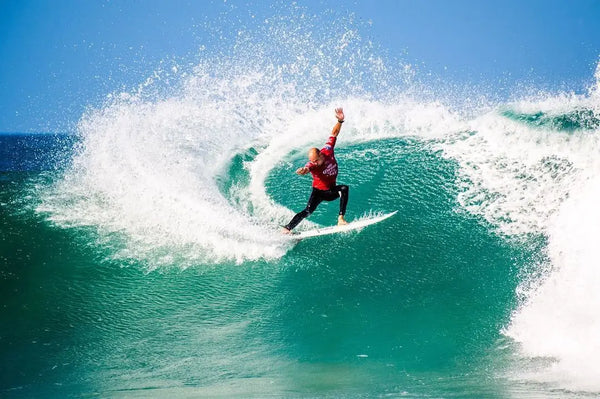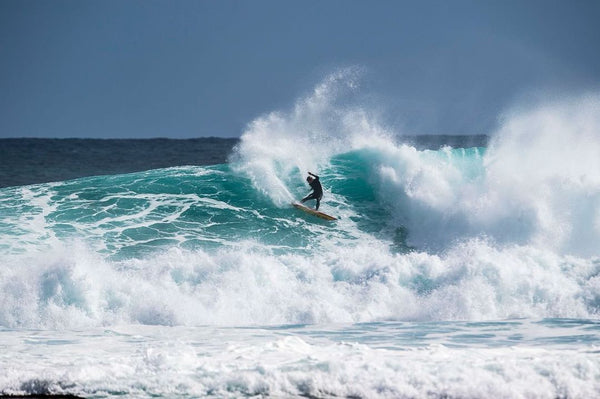Surf Maneuvers Series PART 6: The Down Carve
Share
Tip 6: The Down Carve
Surf Maneuvers Series by Hawaiian South Shore:
- Surf Maneuvers Series Tip 1: Taking Off on a Shortboard
- Surf Maneuvers Series Tip 2: Pumping Down the Line
- Surf Maneuvers Series Tip 3: Bottom Turn/Top Turn Combo
- Surf Maneuvers Series Tip 4: Floaters and Foam Climbs
- Surf Maneuvers Series Tip 5: Roundhouse Cutback
- Surf Maneuvers Series Tip 7: Layback Snap
While down carves have technically been around for decades, they have only begun to score high in recent years, largely due to guys like John John Florence, who have taken this foundational maneuver and pushed it to the limit.
The down carve is sort of like a combination between a top turn and a roundhouse. While it involves taking the board to the crest of the wave and utilizing the entire face, it is a fully committed rail turn rather than a snap. And because it is done so radically and with so much speed in the most critical section of the wave, it almost appears to defy physics.
Full-rail carves are a go-to maneuver in any good surfer’s repertoire, especially those who value power and flow, such as Andy Irons, Taylor Knox, Kelly Slater, John John Florence, and more recently Ethan Ewing. A rail carve is exactly what it sounds like—a drawn-out rail turn that is done with so much speed and power that it buries the rail and appears to carve the face of the wave like a knew through a turkey.

@kellyslater
But the down carve takes this power approach and radicalizes it, creating a punctuating maneuver that, when done correctly, is equally as impressive as a full-rotation air. In fact, these days, there are arguably fewer people who can do a world-class down carve than there are those who can stop 360 airs.
While we mere mortals might not never turn as hard as John John, there’s no reason we can’t add the down carve to our arsenal and develop it to the point where it feels damned good—and believe me when I say that there’s very little in surfing that feels better than a proper rail carve in a critical section.

@john_john_florence
When approaching a section for a frontside down carve, ensure you have a lot of speed, as momentum makes power maneuvers easier to control and push through. Choose a relatively steep section, but not top-to-bottom—you want there to be a lip, but you don’t want it to be the dominant feature of the wave. Bottom turn as if you were going up for a top turn, but as you approach the top third of the wave, shift your approach and your mindset away from a snap and instead toward carving.
Initiate the turn similar to a roundhouse performed out on the shoulder, except that you are in a much more critical section of the wave and your board is directed up toward the lip rather than out toward the shoulder. This is why speed is so important—you need every bit of momentum you can muster to perform a carve in such a critical position, where the first part of your turn is almost going against the grain of the wave.
Keeping your back arm aligned with your inside rail and “planting” your front arm in space as a pivot point, transition to the outside rail and initiate your carve while the board is still traveling up toward the lip. Rather than hitting the lip, aim to bury the rail around a foot below it, ensuring that you commit to the carving motion rather than pushing the board into a fast, loose snap. As the rail engages, push through with your back arm, pivoting around the axis provided by your front arm, which is pointing down the face of the wave toward the trough. Leading with your head is essential with this maneuver, as any failure to commit to a head-shoulders-torso-lower body progression will result in a layback snap (best case scenario) or a bogged rail (worst case scenario). The goal here isn’t to do a layback—it’s to do something much more radical, fluid, and pure, so commit to the rail turn and follow through with that back arm.
As the board passes the zenith of the turn, the tendency will be to take your foot off the accelerator and readjust to the inside rail. Fight this tendency, and instead continue to push through the turn, keeping the outside rail in the water and following through with your body and momentum. The back arm is key to doing this correctly—the minute you drop your back arm, your momentum is shot, so make sure you continue to push through the turn, letting your hand mirror your inside rail (which is currently the only part of the board that is out of the water). As the carve continues nearly to the 180-degree mark and the nose redirects toward the base of the wave, keep the rail buried and remain committed to the turn. The follow through during the final portion of this maneuver is what separates the pros from the pretenders—but there’s no reason we can’t commit to our turns just as much as the best surfers in the world. With the outside rail still buried, the board is literally carving down the face of the wave—as committed as a power turn can get, and every big as radical as a fins-free gaff or a big alley oop.
When you get to the bottom of the wave, you will be going just as fast, if not faster, than when you began the turn, due to the fact that you are literally carving down the wave’s face, tapping into both gravity and the power of the swell. There’s a good chance that the nose will get buried at this point, but with enough speed and power you will be able to push through and recover, content in the knowledge that you just did the biggest turn of your life. As it turns out, you don’t have to blow the fins out the back to get radical!
